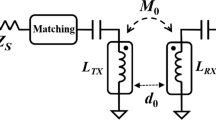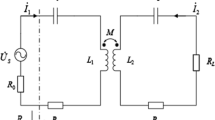Abstract
In a recent trend, near distance wireless power transfer (WPT) for low-power applications has increased exponentially. However, issues such as high harmonic content at the input side of the transmission coil and very low WPT efficiency are persistent. Therefore, a new magnetic resonance WPT (MRWPT) system has been proposed to overcome the aforementioned issues. This paper introduces an LC compensated half-bridge class-D inverter, which minimizes the harmonic content from the input source and makes the MOSFET of the inverter perform zero voltage switching. Simultaneously, a matching capacitor is connected between the resonant coil and the compensated inverter to suppress the reactive power loss. In addition, a series–parallel (SP) structured resonance coil has been introduced for low-power applications due to its high-efficiency WPT capability in near and mid-range distances. The introduced structure acts as a current source-transmitting resonator and a voltage source receiving resonator, which ensures the guaranteed resonance regardless of load variations. The performance of the proposed MRWPT system is analyzed using two-port scattering or S-parameter in the high-frequency structure simulation (HFSS) of ANSYS software. To validate the performance of the simulated system, an experimental 7 W setup has been designed to charge a mobile device.













Similar content being viewed by others
References
Brown, W.C.: The history of power transmission by radio waves. IEEE Trans. Microw. Theory Tech. 32(9), 1230–1242 (1984)
Kurs, A., Karalis, A., Moffatt, R., Joannopoulos, J.D., Fisher, P., Soljaˇci´c, M.: Wireless power transfer via strongly coupled magnetic resonances. Science 317(5834), 83–86 (2007)
Feng, H., Tavakoli, R., Onar, O.C., Pantic, Z.: Advances in high-power wireless charging systems: overview and design considerations. IEEE Trans Trans Electrificat 6(3), 886–919 (2020)
Kobayashi, K., Pontefract, T., Kamiya, Y., Daisho, Y.: Development and performance evaluation of a noncontact rapid charging inductive power supply system for electric micro-bus. IEEE Vehicle Power Propul Conf. 2011, 1–6 (2011)
Hui, S.Y.R., Zhong, W., Lee, C.K.: A critical review of recent progress in midrange wireless power transfer. IEEE Trans Power Electron. 29(9), 4500–4511 (2014)
Chen, L., Liu, S., Zhou, Y.C., Cui, T.J.: An optimizable circuit structure for high-efficiency wireless power transfer. IEEE Trans Indust Electron. 60(1), 339–349 (2013)
Pham, T.S., Nguyen, T.D., Tung, B.S., et al.: Optimal frequency for magnetic resonant wireless power transfer in conducting medium. Sci Reports. 11, 18690 (2021)
Shevchenko, V., Husev, O., Strzelecki, R., Pakhaliuk, B., Poliakov, N., Strzelecka, N.: Compensation topologies in IPT systems: Standards, requirements, classification, analysis, comparison and application. IEEE Access 7, 120559–120580 (2019)
Zhang, W., Mi, C.C.: Compensation topologies of high-power wireless power transfer systems. IEEE Trans Vehicul Technol. 65(6), 4768–4778 (2016)
Sallan, J., Villa, J.L., Llombart, A., Sanz, J.F.: Optimal design of ICPT systems applied to electric vehicle battery charge. IEEE Trans Indust Electron. 56(6), 2140–2149 (2009)
Feng, J., Li, Q., Lee, F.C., Minfan, Fu.: LCCL-LC resonant converter and its soft switching realization for omnidirectional wireless power transfer systems. IEEE Trans. Power Electron. 36(4), 3828–3839 (2021)
Geng, Y., Li, B., Yang, Z., Lin, F., Sun, Hu.: A high efficiency charging strategy for a supercapacitor using a wireless power transfer system based on inductor/ capacitor/capacitor (LCC) compensation topology. Energies 10, 1 (2017)
Jeong, C.H., Choi, S.J.: Graphical design plane analysis for series-compensated resonant energy links of inductive wireless power transfer systems. J Power Electron. 19(6), 1440–1448 (2019)
Liu, Xu., Clare, L., Yuan, X., Wang, C., Liu, J.: A design method for making an LCC compensation two-coil wireless power transfer system more energy efficient than an SS counterpart. Energies 10, 9 (2017)
Shin, H., Chung, E., Ha, J.-I.: Cost-effective high-performance digital control method in series-series compensated wireless power transfer system. Electronics 9, 11 (2020)
Truong, C.-T., Choi, S.-J.: Investigation of scale conversion for inductive power transfer in series-series configuration. Electronics 9, 11 (2020)
Yang, Y., Cui, J., Cui, X.: Design and analysis of magnetic coils for optimizing the coupling coefficient in an electric vehicle wireless power transfer system. Energies 13, 16 (2020)
Zhang, Y., Yan, Z., Kan, T., Zeng, X., Chen, S., Mi, C.C.: Modeling and analysis of a strongly coupled series–parallel compensated wireless power transfer system. IEEE J Emerg Select Top Power Electron. 7(2), 1364–1370 (2019)
Czarkowski D, Kazimierczuk MK. 2011 Resonant Power Converters. Wiley IEEE Press. 2 edition
Rivas, J.M., Han, Y., Leitermann, O., Sagneri, A.D., Perreault, D.J.: A high-frequency resonant inverter topology with low-voltage stress. IEEE Trans. Power Electron. 23(4), 1759–1771 (2008)
RJ Calder, SH Lee, RD Lorenz. 2013 Efficient, mhz frequency, resonant converter for sub-meter (30 cm) distance wireless power transfer. In: 2013 IEEE Energy Conversion Congress and Exposition. 1917–1924
MK Uddin, G Ramasamy, S Mekhilef, K Ramar, YC Lau. 2014 A review on high frequency resonant inverter technologies for wireless power transfer using magnetic resonance coupling. In: IEEE Conference on Energy Conversion (CENCON). 412–417
Kaczmarczyk, Z.: High-efficiency class E, EF2, and E/F3 inverters. IEEE Trans. Industr. Electron. 53(5), 1584–1593 (2006)
Jiang, C., Chau, K.T., Liu, C., ChristopherLee, H.T.: An overview of resonant circuits for wireless power transfer. Energies 10(7), 894 (2017)
Li, S., Li, W., Deng, J., Nguyen, T.D., Mi, C.C.: A doublesided LCC compensation network and its tuning method for wireless power transfer. IEEE Trans Vehicul Technol. 64(6), 2261–2273 (2015)
LC Filter Design, An Application Report by Texas Instruments. (2016)
Yi, K.H.: 6.78 MHz capacitive coupling wireless power transfer system. J Power Electron 15(4), 987–993 (2015)
Zhang, Y., Yan, Z., Liang, Z., Li, S., Mi, C.C.: A high-power wireless charging system using LCL-N topology to achieve a compact and low-cost receiver. IEEE Trans Power Electron 35(1), 131–137 (2020)
Zhang, W., Mi, C.C.: Compensation topologies of high-power wireless power transfer systems. IEEE Trans. Veh. Technol. 65(6), 4768–4778 (2016)
Moradewicz, A.J., Kazmierkowski, M.P.: Contactless energy transfer system with FPGA-controlled resonant converter. IEEE Trans. Industr. Electron. 57(9), 3181–3190 (2010)
Wang, C.S., Stielau, O.H., Covic, G.A.: Design considerations for a contactless electric vehicle battery charger. IEEE Trans Indust Electron 52(5), 1308–1314 (2005)
Moon, J., Hwang, H., Jo, B., Kwon, C.K., Kim, T.G., Kim, S.W.: Design and implementation of a high efficiency 6.78 MHz resonant wireless power transfer system with a 5 W fully integrated power receiver. IET Power Electron 10(5), 557–587 (2017)
Acknowledgements
This research was supported by the Daegu University Research Grant, 2020.
Funding
Daegu University Research Grant, 2020.
Author information
Authors and Affiliations
Corresponding author
Rights and permissions
Springer Nature or its licensor (e.g. a society or other partner) holds exclusive rights to this article under a publishing agreement with the author(s) or other rightsholder(s); author self-archiving of the accepted manuscript version of this article is solely governed by the terms of such publishing agreement and applicable law.
About this article
Cite this article
Kumar, V., Yi, K. 6.78 MHz loosely coupled inductive wireless power transfer with series–parallel resonators. J. Power Electron. 23, 355–362 (2023). https://doi.org/10.1007/s43236-022-00552-5
Received:
Revised:
Accepted:
Published:
Issue Date:
DOI: https://doi.org/10.1007/s43236-022-00552-5




